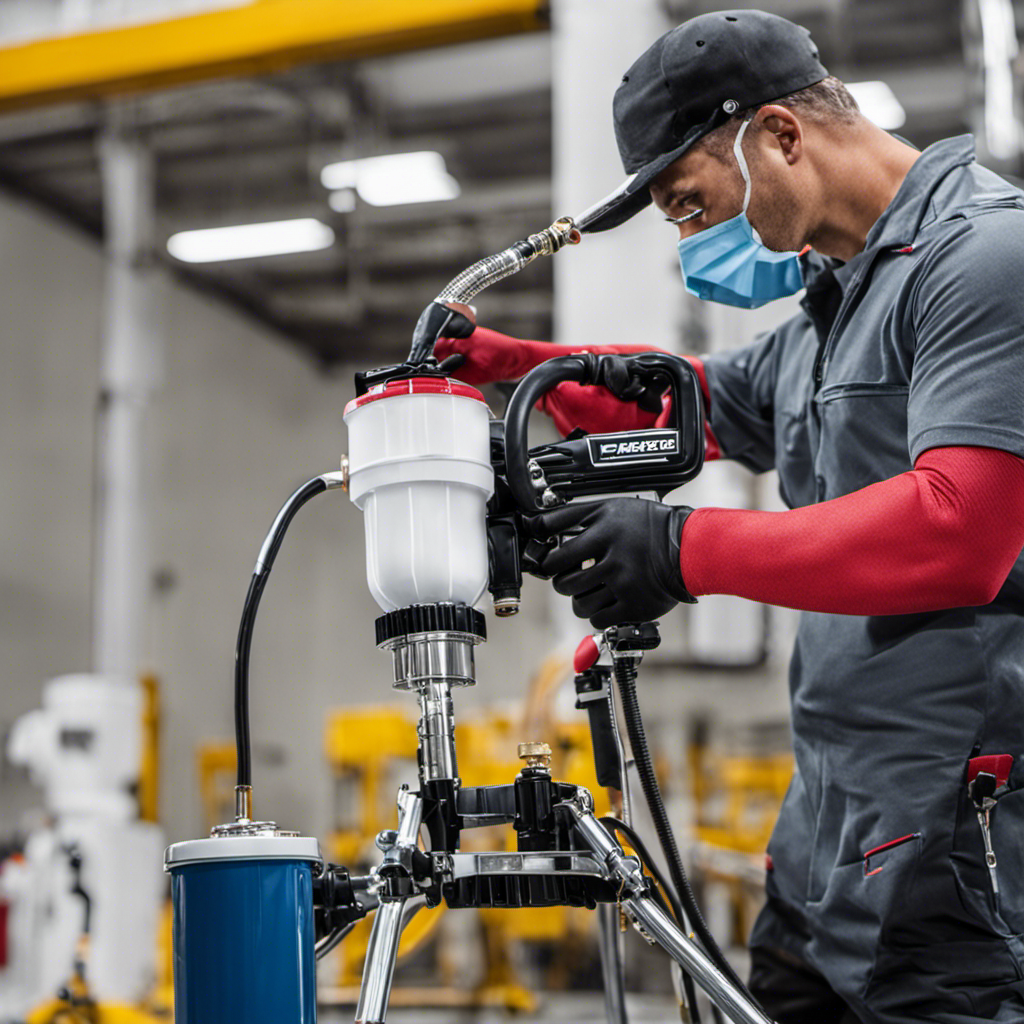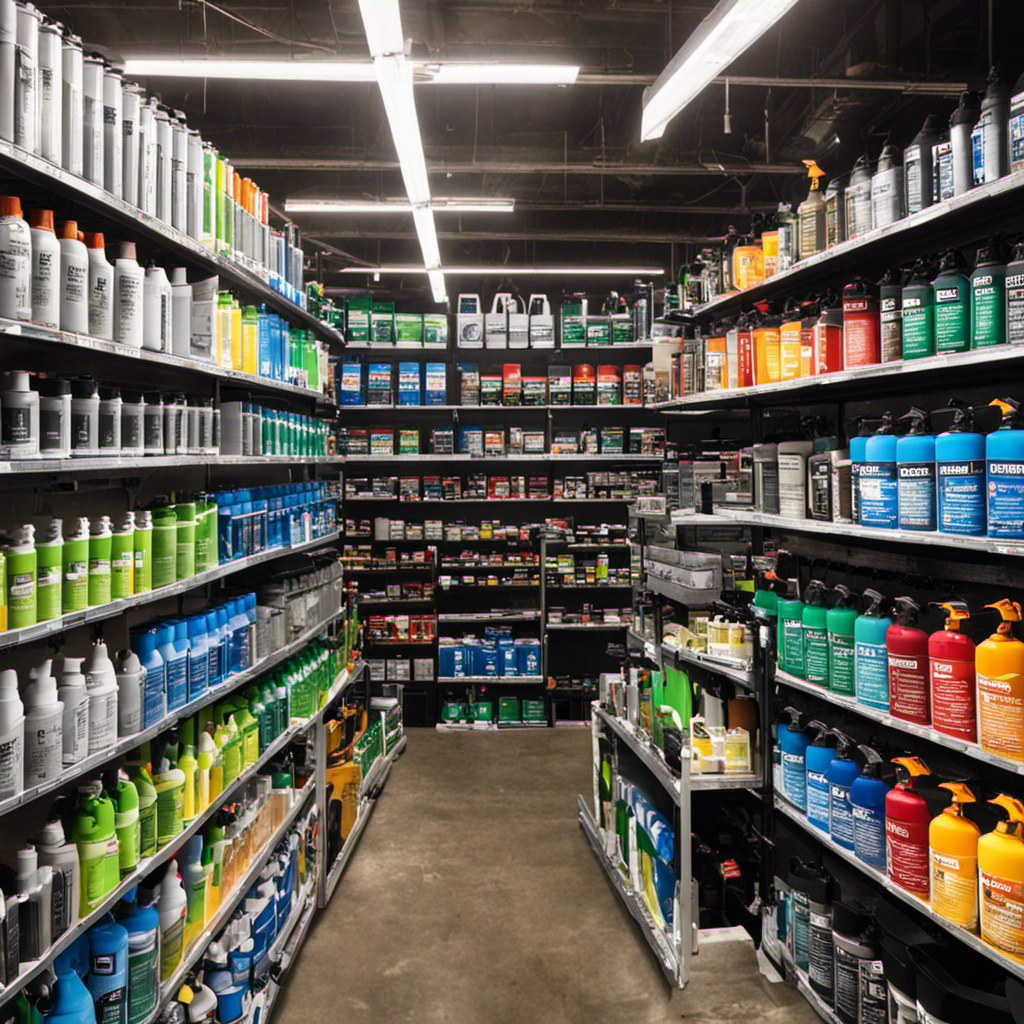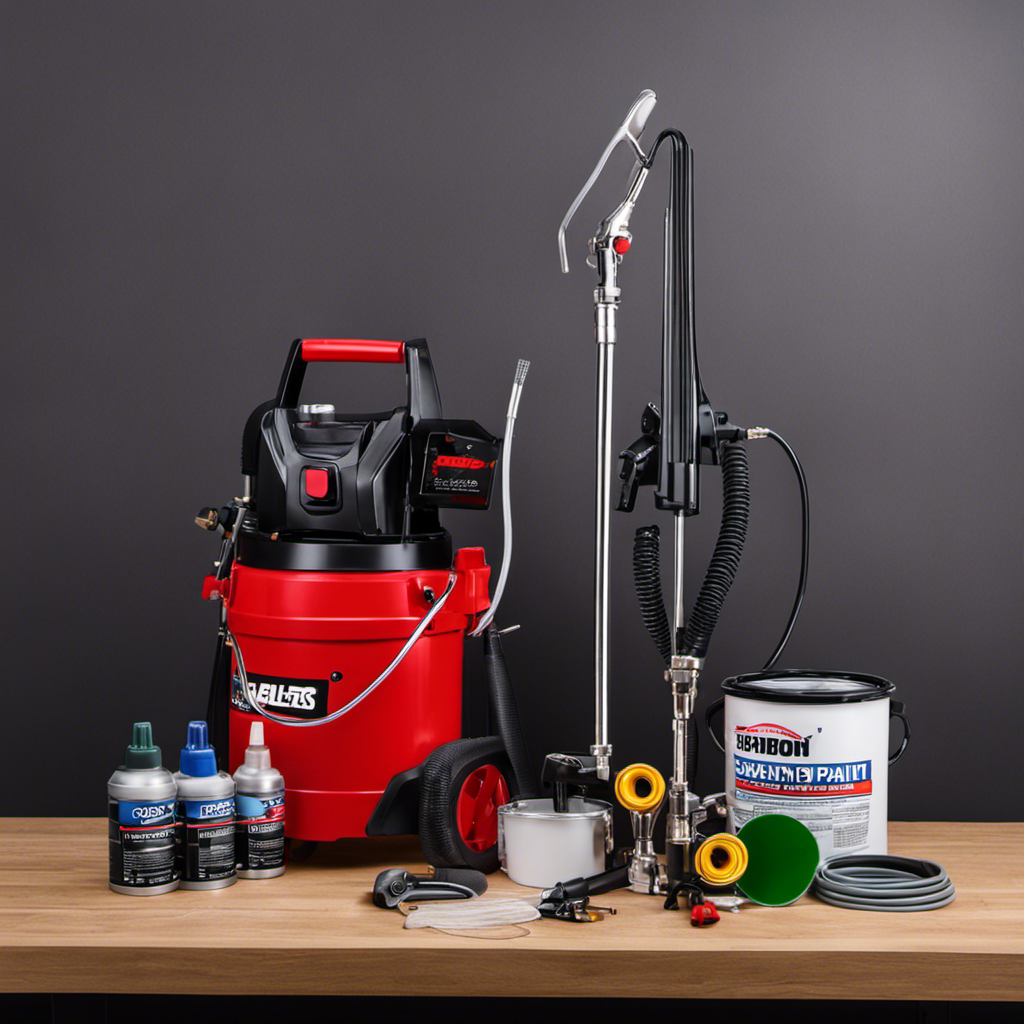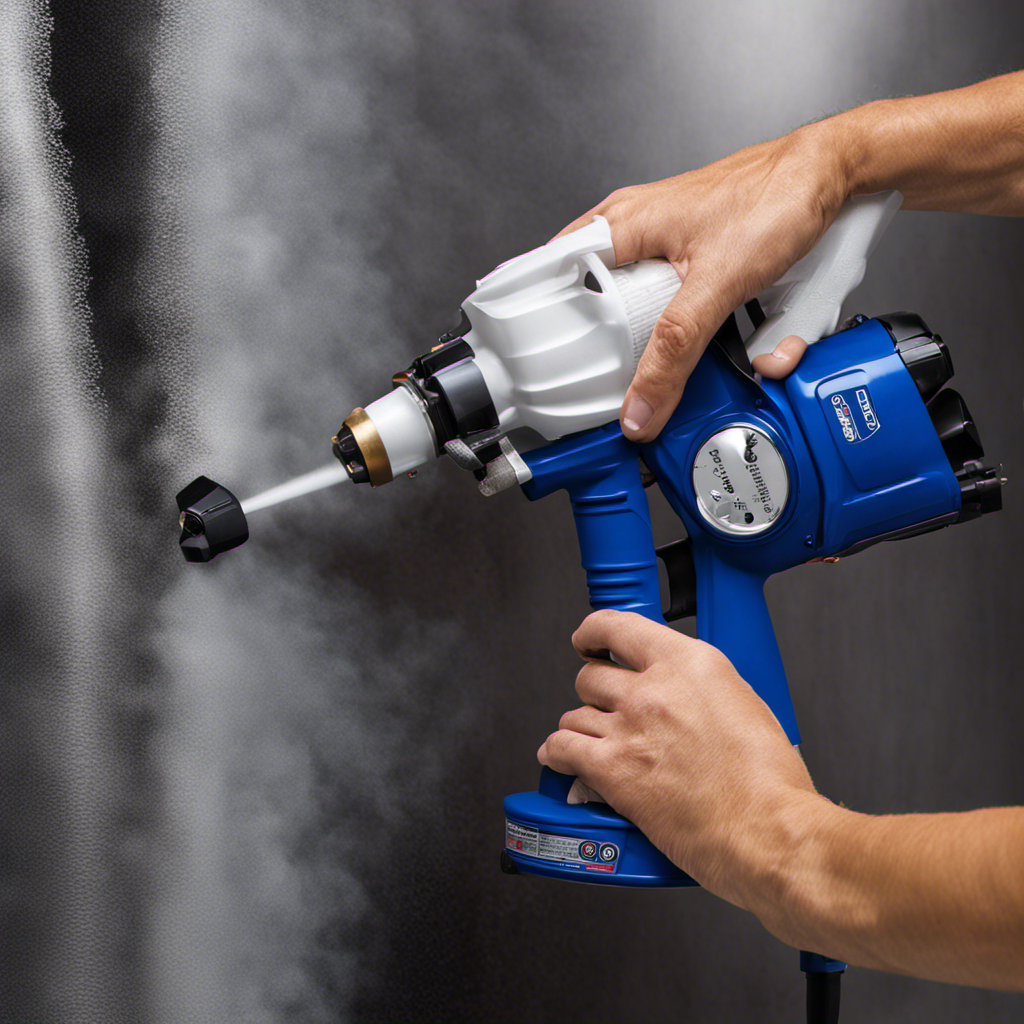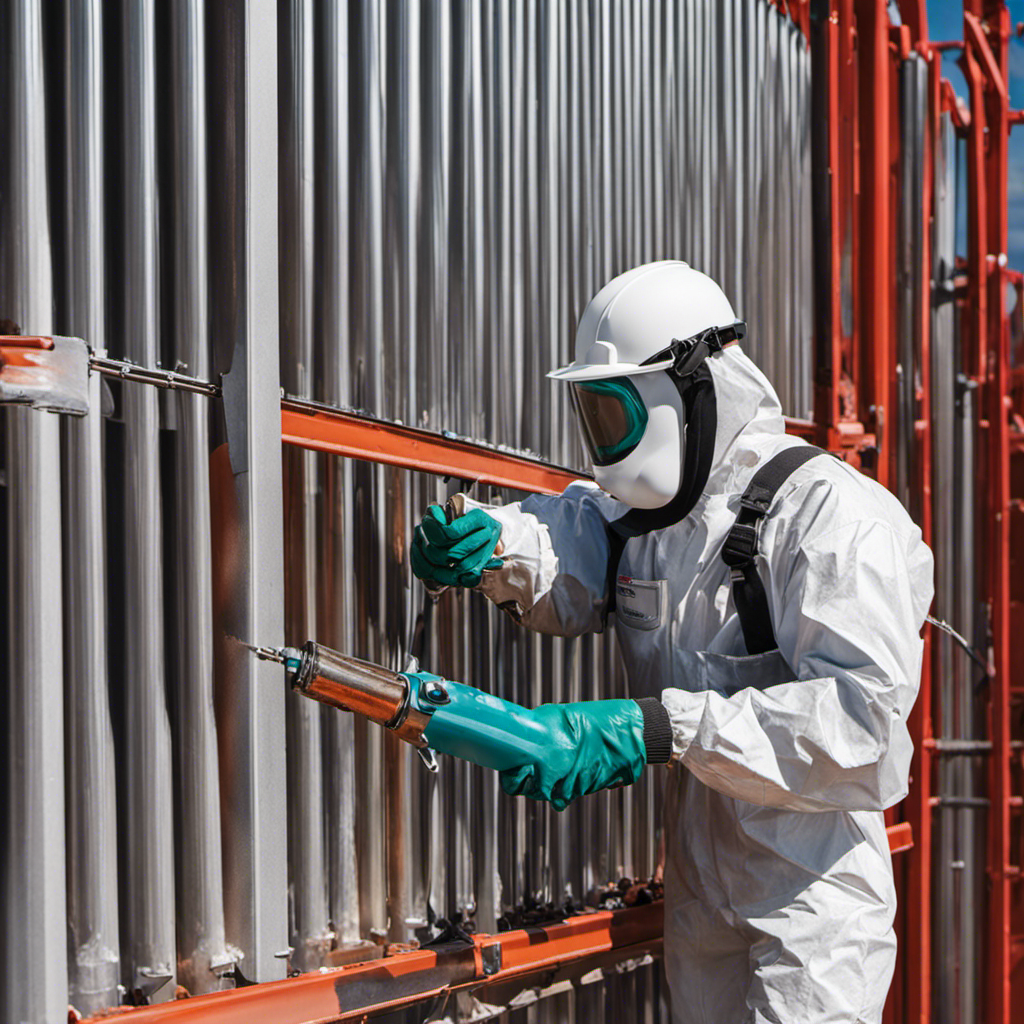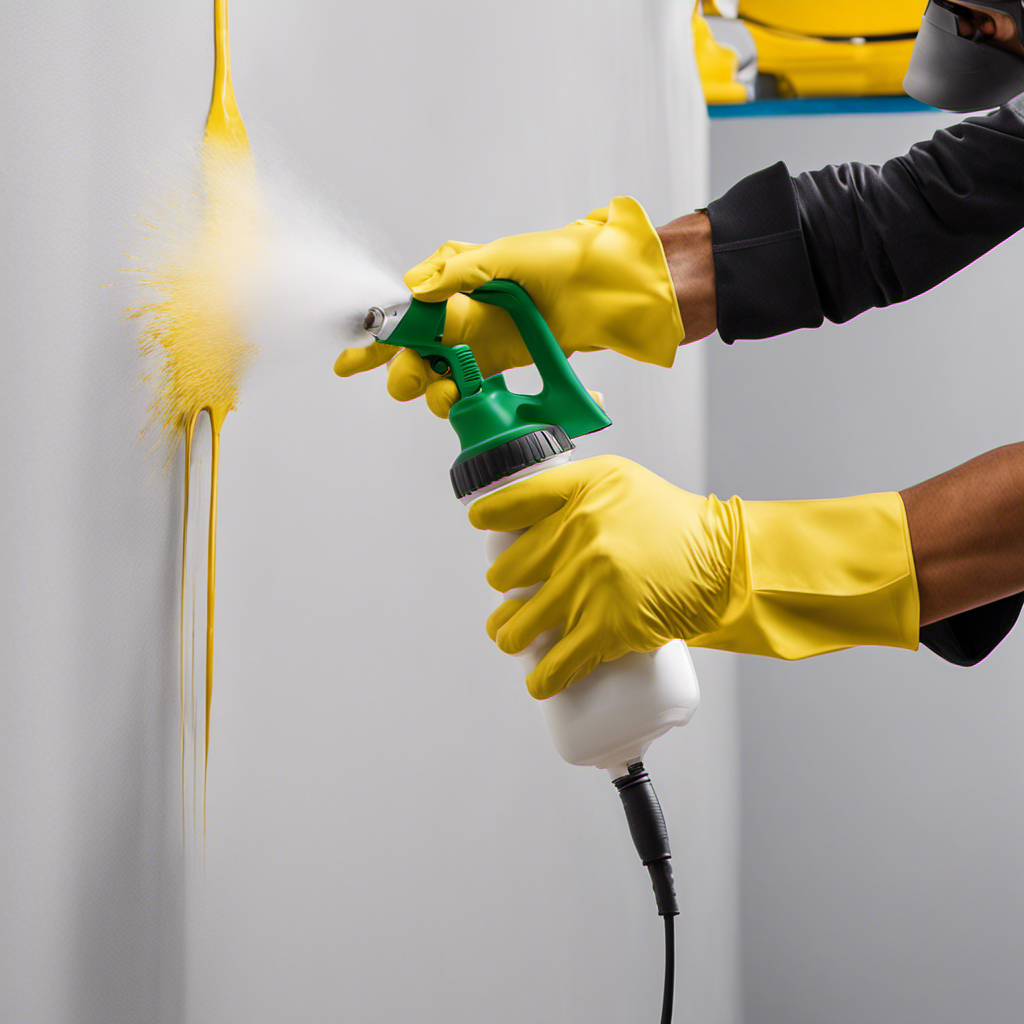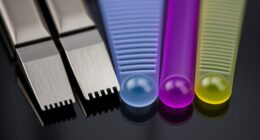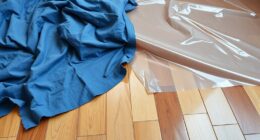It is essential to regularly maintain and clean your airless paint sprayer in order to ensure it works efficiently and effectively. The in-depth instructions found in our comprehensive guide on cleaning an airless paint sprayer will give readers all the information they need to keep their device durable and performing well.
From disconnecting and relieving pressure to cleaning the spray tip, guard, and filter, this guide covers it all.
With proper cleaning and regular maintenance, painters can ensure their sprayers last longer and save time and money in the process.
So, let’s dive in and learn how to give our airless paint sprayers the TLC they deserve.
Key Takeaways
- Disconnect and relieve pressure before cleaning
- Clean the spray tip, guard, and filter with warm soapy water
- Remove dried paint and debris from the sprayer
- Regular cleaning extends the lifespan of the sprayer and saves time and money
Disconnecting and Relieving Pressure
Before cleaning the airless paint sprayer, the user should disconnect and relieve pressure by activating the trigger, ensuring safety during the cleaning process.
Proper ventilation is crucial during this process to prevent the inhalation of harmful fumes. It is important to work in a well-ventilated area or use respiratory protection to minimize exposure to paint particles and solvents.
Additionally, proper disposal of paint waste is essential for environmental safety. Unused paint should be collected in a tightly sealed container and disposed of according to local waste management guidelines. Small amounts of paint can be disposed of in regular trash if permitted, while larger amounts may need to be brought to a hazardous waste disposal site.
Following these guidelines ensures the safety of both the user and the environment.
Cleaning the Spray Tip, Guard, and Filter
To clean the spray tip, guard, and filter, the user should use warm soapy water and a cleaning brush with stiff bristles to scrub away any paint or debris. This ensures that the spray tip remains clear and allows for a consistent and even spray pattern.
It is important to use a cleaning brush with stiff bristles to effectively remove any dried paint or build-up that may accumulate over time.
Choosing the right cleaning agent is also crucial for proper maintenance of the airless paint sprayer. It is recommended to compare different options and their effectiveness. Some common cleaning agents include mineral spirits, water-based solutions, or manufacturer-recommended cleaning agents.
Proper techniques and troubleshooting tips should also be considered to ensure that the spray tip, guard, and filter are thoroughly cleaned and in optimal condition for future use.
Removing Dried Paint and Debris
The user can effectively remove dried paint and debris from the airless paint sprayer by using a cleaning brush with stiff bristles to scrub away any buildup. This cleaning technique is crucial for preventing clogs and maintaining the sprayer’s optimal performance.
Over time, paint can dry and accumulate on various components of the sprayer, such as the spray gun and nozzles. By diligently cleaning these parts, users can ensure a consistent spray pattern and prevent blockages that could lead to costly repairs or replacements.
It is important to use a cleaning brush with stiff bristles to thoroughly scrub away any dried paint or debris. Regularly cleaning the airless paint sprayer in this manner will extend its lifespan and contribute to efficient, hassle-free painting projects.
Reassembling and Testing the Sprayer
After thoroughly cleaning the airless paint sprayer, the user can reassemble it by securely attaching the pressure relief valve, reconnecting the paint hose with a tight seal, and ensuring all connections are securely attached and aligned.
This step is crucial in ensuring proper paint flow and consistency during future use. Once the sprayer is reassembled, the user should proceed with testing its performance.
This involves turning on the sprayer and spraying water onto a test surface to check for any issues such as clogs, leaks, or inconsistent spray patterns. Testing the sprayer’s performance not only ensures that it is functioning properly but also provides peace of mind that it will deliver the desired results when using paint.
Necessary Cleaning Supplies and Safety Precautions
When cleaning an airless paint sprayer, it is important for the user to have the necessary cleaning supplies and safety precautions.
Proper cleaning agent selection and disposal methods are crucial for maintaining the longevity and efficiency of the sprayer. Using warm water and a cleaning agent designed specifically for paint sprayers ensures effective cleaning without damaging the equipment.
Additionally, having a bucket or container for the cleaning solution, a cleaning brush with stiff bristles, and clean rags or towels for wiping down the sprayer are essential supplies.
To ensure safety, users should wear gloves and safety glasses during the cleaning process.
Proper disposal methods include collecting excess paint in a tightly sealed container and following local waste management guidelines for disposal or bringing larger amounts to a hazardous waste disposal site if required.
Regular Maintenance and Cleaning Tips
After discussing the necessary cleaning supplies and safety precautions for cleaning an airless paint sprayer, it is important to understand the regular maintenance and cleaning tips that can help prolong the longevity and efficiency of the sprayer.
Regular maintenance is crucial to ensure optimal performance and prevent any issues that may arise from neglecting the cleaning process. Here are some helpful tips:
-
Cleaning Frequency: Clean the airless paint sprayer after every use to prevent paint buildup and maintain its functionality.
-
Best Cleaning Agents: Use appropriate solvents like mineral spirits or water-based solutions to effectively clean the sprayer and remove any paint residue.
-
Thorough Cleaning: Pay attention to cleaning the spray tip, guard, and filter with warm soapy water to ensure proper functioning.
-
Component Inspection: Regularly inspect the sprayer for reduced pressure output, inconsistent spray patterns, or leaking to address any potential issues promptly.
Frequently Asked Questions
How Often Should I Clean My Airless Paint Sprayer?
Cleaning an airless paint sprayer regularly is crucial for prolonging its lifespan and ensuring optimal performance. Proper maintenance includes cleaning the spray tip, guard, and filter with warm soapy water, removing dried paint and debris, and testing the sprayer for proper functioning.
By following these tips for effective cleaning, such as using appropriate solvents and cleaning the suction tube, you can prevent clogs and maintain the sprayer’s efficiency.
It is recommended to clean the airless paint sprayer after every use to keep it in top condition.
What Type of Cleaning Agent Should I Use for My Paint Sprayer?
When it comes to cleaning an airless paint sprayer, choosing the right cleaning agent is crucial. There are several alternative cleaning agents available, each with its own pros and cons.
Some commonly used options include mineral spirits, water-based solutions, and specialized paint sprayer cleaning agents. Mineral spirits are effective at removing oil-based paints, but they can be toxic and require proper ventilation.
Water-based solutions are environmentally friendly but may not be as effective on stubborn paint residues. Specialized paint sprayer cleaning agents offer the best results but can be more expensive.
Ultimately, the choice depends on the type of paint and the level of cleaning required.
Can I Reuse the Cleaning Solution for Multiple Cleanings?
Yes, it is possible to reuse the cleaning solution for multiple cleanings of an airless paint sprayer. However, it is important to note that the effectiveness of the solution may diminish over time as it becomes contaminated with paint residue.
It is recommended to strain the solution after each use to remove any debris and store it in a tightly sealed container. Alternatively, some users prefer to use alternative cleaning methods such as using solvents like mineral spirits or water-based solutions.
How Should I Dispose of the Excess Paint Waste?
Proper disposal of excess paint waste is essential to minimize environmental impact. One interesting statistic to consider is that in the United States alone, approximately 64 million gallons of leftover paint are improperly disposed of each year.
To ensure responsible disposal, it is recommended to collect excess paint in a tightly sealed container and check local waste management guidelines for disposal methods. Small amounts of paint may be disposed of in regular trash if allowed, while larger quantities may require disposal at a hazardous waste facility.
Following proper disposal practices helps protect our environment.
Is It Necessary to Clean the Suction Tube Every Time I Use the Sprayer?
Proper maintenance of an airless paint sprayer includes cleaning the suction tube after each use. This is necessary to ensure proper paint flow and prevent clogs. By cleaning the suction tube regularly, you can save time and avoid interruptions during your painting projects.
It is a time-saving tip that contributes to the longevity and efficiency of the sprayer. Additionally, following this maintenance practice helps maintain consistent pressure output, spray patterns, and prevents leaking.
Conclusion
In conclusion, regular cleaning of an airless paint sprayer is vital for its longevity and efficiency. By following the proper steps, such as disconnecting and relieving pressure, cleaning the spray tip, guard, and filter, and removing any dried paint or debris, users can ensure the sprayer’s optimal performance.
Additionally, conducting regular maintenance and troubleshooting any issues will further prolong the sprayer’s lifespan. With the ultimate guide provided, users can confidently clean their sprayers, saving time and money in the long run.
It’s a must-have tool in every painter’s arsenal, making the cleaning process as easy as a breeze.
Drenched in creativity and armed with a fountain pen, Isolde weaves words as gracefully as a painter strokes their canvas. A writer for Paint Sprayer Zone, her passion for colors, textures, and spaces finds a harmonious blend with her profound knowledge of painting tools and techniques.
Having grown up in a family of artists, Isolde’s tryst with paints began early. While her relatives expressed themselves on canvas, Isolde found her medium in words. She dedicated herself to chronicling the world of painting, understanding the nuances of each tool, and the artistry behind every spritz of a paint sprayer.
